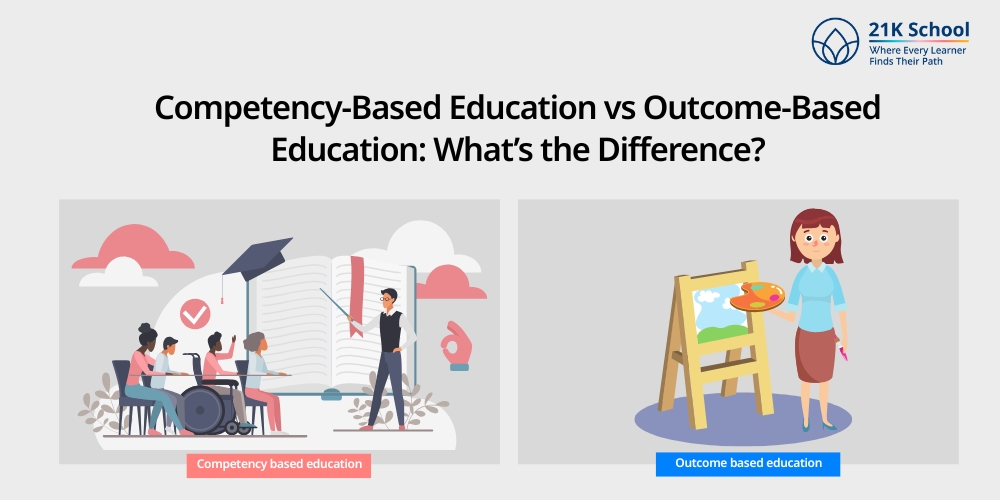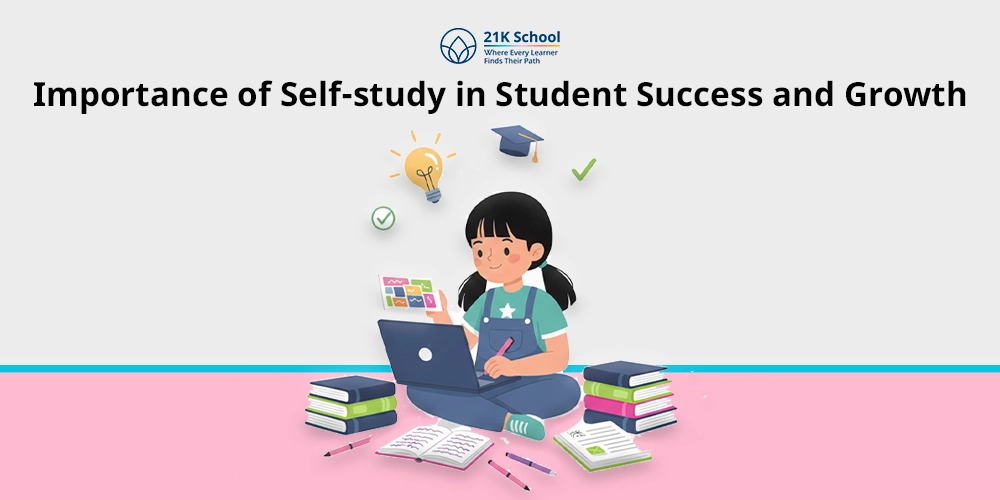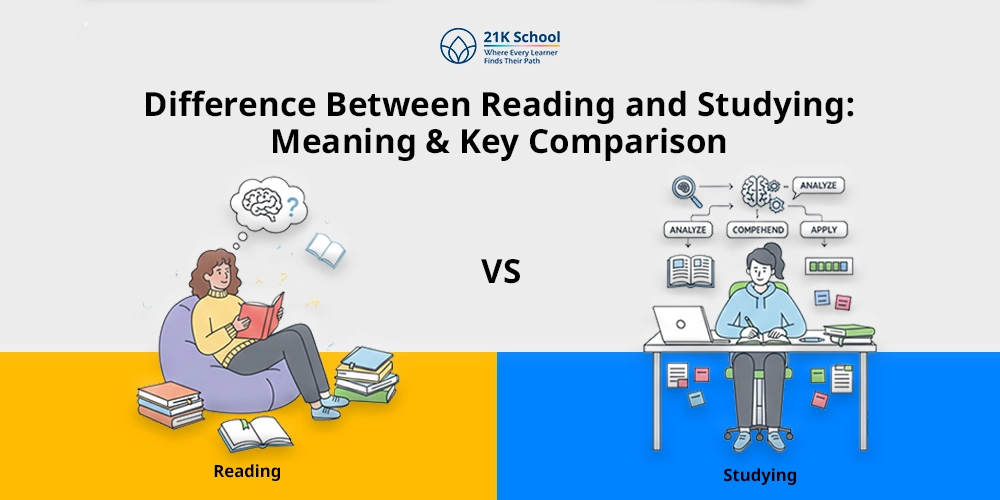
Education relies on different proven and effective methods which help kids to improve their abilities.
Various modern approaches for example, Competency-Based Education and Outcome-Based Education are useful for academics and personal growth.
By understanding and implementing these methods effectively will help in reaching the desired goals.
Let’s learn what competency-based education and outcome-based education is and the main differences between to execute effectively.
Table of Contents
What is Competency Based Education?
Competency based education also famous as, CBE is a learning technique that mainly focuses on skills enhancement, knowledge, and abilities.
Instead of time spent in the classroom or traditional grades, competency based education moves forward only after learners show they are good at certain skills or knowledge.
In simple words, CBE focuses on students “Can Do” things which they have learned instead of just gaining knowledge.
What is Outcome Based Education?
Outcome based education is a student-centered method. The main focus is on what students are expected to achieve by the end of an educational experience.
Here everything from curriculum to assessments are designed based on achieving outcomes.
OBE is often time-bound and structured around academic timelines.
Key Differences Between Competency Based Education vs Outcome Based Education
Given below is a detailed difference between competency based education vs outcome based education for students:
| S No. | Aspects | Competency-Based Education | Outcome-Based Education |
| 1. | Focus of the Approach | Competency-based education focuses on mastery of various skills and competencies which can be applied in real-life scenarios. | Outcome-based education aligns learning activities and assessments with predefined learning goals and outcomes for a course or program. |
| 2. | Progression Criteria | Students advance upon mastery of a competency, regardless of time. | The progress of students depends on completing the curriculum in a fixed time. The main aim is to meet results. |
| 3. | Learning Pace | Competency-based education is highly flexible. It allows learners to advance at their own pace. The schedule is not fixed. | Outcome-based education follows a more structured timeline and academic calendar. Also, teaching and testing are synchronised with milestones. |
| 4. | Assessment Style | Competency-based education is based on formative, performance-based assessments. Some common examples are simulations, projects, and portfolios to evaluate application of skills. | Outcome-based education primarily uses summative assessments. Examples like exams, assignments, and final projects to measure learning at the end of a term. |
| 5. | Curriculum Design | Curriculum design here is around skills and tasks students need to master. | Curriculum design here is created around educational goals and intended learning results. |
| 6. | Teaching Approach | Competency-based education focuses on individualised learning plans, mentoring, and coaching. | Outcome based education focuses on structured instruction aligned to learning outcomes. |
| 7. | Flexibility | Get highly flexibility especially in terms of time, pace, and learning path | Get moderately flexible, but tied to institutional schedules and assessment deadlines. |
| 8. | Measurement of Success | Here success equals to demonstrated competency in each skill. | In outcome-based education the achievement of learning outcomes, often measured by test scores or project completion. |
| 9. | Learner Role | It guides learners to take ownership of their learning. Also, track progress, and direct their own educational journey. | Outcome based education offers a more guided and structured path. Here, learners follow a pre-defined course structure. |
| 10. | Application Context | It can be applied in vocational, technical, and adult education programs. | It is commonly applied in K-12, higher education, and systems driven by accreditation standards. |
Get an in-depth explanation of key differences between competency based education and outcome based education.
1. Focus of the Approach
- CBE: The CBE is popular for improving particular skills and competencies in students.
- OBE: The OBE centers on achieving pre-defined learning outcomes or goals.
2. Progression Criteria
- CBE: Instead of time learners mastery of a competency.
- OBE: In OBE learners progression criteria is based on completing the curriculum on time. The objective is to meet the outcome.
Understand the difference between competency based learning and mastery learning.
3. Learning Pace
- CBE: CBE has a personalised and flexible learning pace for learners especially for special needs students and slow learners.
- OBE: OBE is a time bound approach one needs to match with the curriculum.
4. Assessment Style
- CBE: Competency based education is mainly focused on performance based learning to explore real world scenarios.
- OBE: Outcome based education is outcome-aligned assessments where marksheet or results after exam is shared.
5. Curriculum Design
- CBE: The curriculum is designed based on skills and tasks students want to learn or master.
- OBE: In outcome based education the curriculum is designed to meet educational goals and intended learning results.
6. Teaching Approach
- CBE: Teaching approach in competency based education is majorly focused on individualised learning and mentorship by facilitators.
- OBE: In outcome based education, the teaching approach includes structured instructions to get desired results.
7. Flexibility
- CBE: CBE is more flexible then OBE especially in case of time, pace, and learning path.
- OBE: OBE is less flexible where the curriculum includes fixed time and assessment.
8. Measurement of Success
- CBE: Here the success is measured via competency mastery. Each competency must be demonstrated independently.
- OBE: In OBE, the success is measured at the end of the term or program with a grading scale.
9. Learner Role
- CBE: In CBE learners are active participants of their learning in which they decide their own learning ways, speed and methods.
- OBE: In OBE, learners get guidance from curriculum or syllabus to work accordingly.
10. Application Context
- CBE: For vocational training, technical education, and corporate training it is mostly used.
- OBE: In formal education systems such as schools, universities for academic progress use OBE.
Explore the benefits of competency based education.
Final Thoughts!
The selection of the right approach is based on kids’ learning objectives and style. Competency based education and outcome based education both have their own advantages.
Some common benefits of CBE are flexible, practical application, self-motivation and discipline. While OBE is structured, more dependent and consistent outcomes.
The choice between competency-based education and outcome-based education or using a blended approach depends on students needs, goals and desired outcomes.


